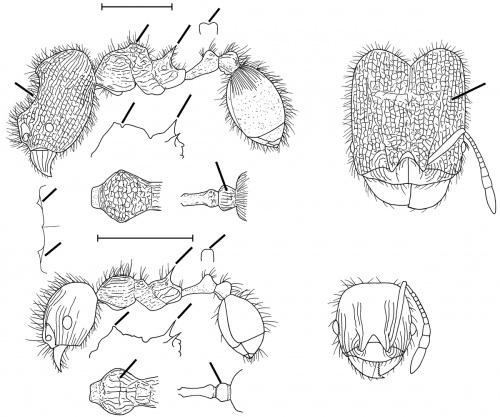Pheidole bufo
| Pheidole bufo | |
|---|---|

| |
| Scientific classification | |
| Kingdom: | Animalia |
| Phylum: | Arthropoda |
| Class: | Insecta |
| Order: | Hymenoptera |
| Family: | Formicidae |
| Subfamily: | Myrmicinae |
| Tribe: | Attini |
| Genus: | Pheidole |
| Species: | P. bufo |
| Binomial name | |
| Pheidole bufo Wilson, 2003 | |
James Trager found the workers of the type colony feeding on a crushed scarab larva.
Identification
See the description in the nomenclature section.
Keys including this Species
Distribution
In addition to the type colony from Brazil, the species has been found in Colombia (near Leticia) and Ecuador (Yasuni National Park, near Puerto Tiputini). (Wilson 2003)
Latitudinal Distribution Pattern
Latitudinal Range: -0.6364° to -15.461°.
| North Temperate |
North Subtropical |
Tropical | South Subtropical |
South Temperate |
- Source: AntMaps
Distribution based on Regional Taxon Lists
Neotropical Region: Brazil (type locality), Colombia, Ecuador.
Distribution based on AntMaps
Distribution based on AntWeb specimens
Check data from AntWeb
Countries Occupied
| Number of countries occupied by this species based on AntWiki Regional Taxon Lists. In general, fewer countries occupied indicates a narrower range, while more countries indicates a more widespread species. |

|
Estimated Abundance
| Relative abundance based on number of AntMaps records per species (this species within the purple bar). Fewer records (to the left) indicates a less abundant/encountered species while more records (to the right) indicates more abundant/encountered species. |

|
Biology
Castes
Worker
Minor
Images from AntWeb
    
| |
| Paratype Pheidole bufo. Worker. Specimen code casent0624236. Photographer Jeremy Pilllow, uploaded by University of Utah. | Owned by MCZC. |
Major
Images from AntWeb

| |
| Paratype Pheidole bufo. Worker (major/soldier). Specimen code jtlc000016332. Photographer Jeremy Pilllow, uploaded by University of Utah. | Owned by MCZC. |
Nomenclature
The following information is derived from Barry Bolton's Online Catalogue of the Ants of the World.
- bufo. Pheidole bufo Wilson, 2003: 251, figs. (s.w.) BRAZIL.
Unless otherwise noted the text for the remainder of this section is reported from the publication that includes the original description.
Description
A very distinct member of the distorta group, recognizable by the following traits.
Major: central third of dorsal head surface in side view deeply concave; all of dorsal surface of head except clypeus and frontal triangle, and all of pronotal dorsum, strongly rugoreticulate; hypostoma bidentate; sides of mesosoma and dorsum of postpetiolar node carinulate; anterior third of first gastral tergite finely striate, remainder foveolate and opaque; humerus right-angulate and posteriorly notched in dorsal-oblique view; propodeal spine very large, nearly 2X as long as the basal face of the propodeum anterior to it.
Minor: humerus surmounted by a blunt spine in dorsal-oblique view; propodeal spines nearly as long as the basal propodeal space; mesosoma almost completely covered by longitudinal carinulae.
MEASUREMENTS (mm) Holotype major: HW 1.64, HL 1.92, SL 0.84, EL 0.22, PW 0.78. Paratype minor: HW 0.84, HL 0.82, SL 0.74, EL 0.18, PW 0.54.
COLOR Major and minor: body dark brown, appendages light to medium brown.
Figure. Upper: holotype, major. Lower: paratype, minor. Scale bars = 1 mm.
Type Material
BRAZIL: trail to waterfall, Véu de Noira, Chapada dos Guimarães, Mato Grosso, col. James C. Trager. Museum of Comparative Zoology
Etymology
L bufo, toad.
References
- Wilson, E. O. 2003. Pheidole in the New World: A dominant, hyperdiverse ant genus. Harvard University Press, Cambridge, MA. (page 251, fig. major, minor described)
- Albuquerque, E., Prado, L., Andrade-Silva, J., Siqueira, E., Sampaio, K., Alves, D., Brandão, C., Andrade, P., Feitosa, R., Koch, E., Delabie, J., Fernandes, I., Baccaro, F., Souza, J., Almeida, R., Silva, R. 2021. Ants of the State of Pará, Brazil: a historical and comprehensive dataset of a key biodiversity hotspot in the Amazon Basin. Zootaxa 5001, 1–83 (doi:10.11646/zootaxa.5001.1.1).
- Cantone S. 2018. Winged Ants, The queen. Dichotomous key to genera of winged female ants in the World. The Wings of Ants: morphological and systematic relationships (self-published).
- Franco, W., Ladino, N., Delabie, J.H.C., Dejean, A., Orivel, J., Fichaux, M., Groc, S., Leponce, M., Feitosa, R.M. 2019. First checklist of the ants (Hymenoptera: Formicidae) of French Guiana. Zootaxa 4674, 509–543 (doi:10.11646/zootaxa.4674.5.2).
- Guerrero, R.J., García, E., Fernández, F. 2022. The Pheidole Westwood, 1839 ants (Formicidae: Myrmicinae) in Colombia: new records including two species with remarkable morphology. Zootaxa 5154 (3): 319-332 (doi:10.11646/zootaxa.5154.3.5).
- Przybyszewski, K.R., Silva, R.J., Vicente, R.E., Garcia Freitas, J.V., Pereira, M.J.B., Izzo, T.J., Tonon, D.S. 2020. Can baited pitfall traps for sampling dung beetles replace conventional traps for sampling ants? Sociobiology 67, 376-387 (doi:10.13102/sociobiology.v67i3.5201).
References based on Global Ant Biodiversity Informatics
- Franco W., N. Ladino, J. H. C. Delabie, A. Dejean, J. Orivel, M. Fichaux, S. Groc, M. Leponce, and R. M. Feitosa. 2019. First checklist of the ants (Hymenoptera: Formicidae) of French Guiana. Zootaxa 4674(5): 509-543.
- Santos, J.C., J.H.C Delabie and G.W. Fernandes. 2008. Uma avaliação após 15 anos do efeito do fogo sobre a comunidade de formiga em uma área de floresta amazônica. Revista Brasileira de Entomologia 52(1): 82-87.



